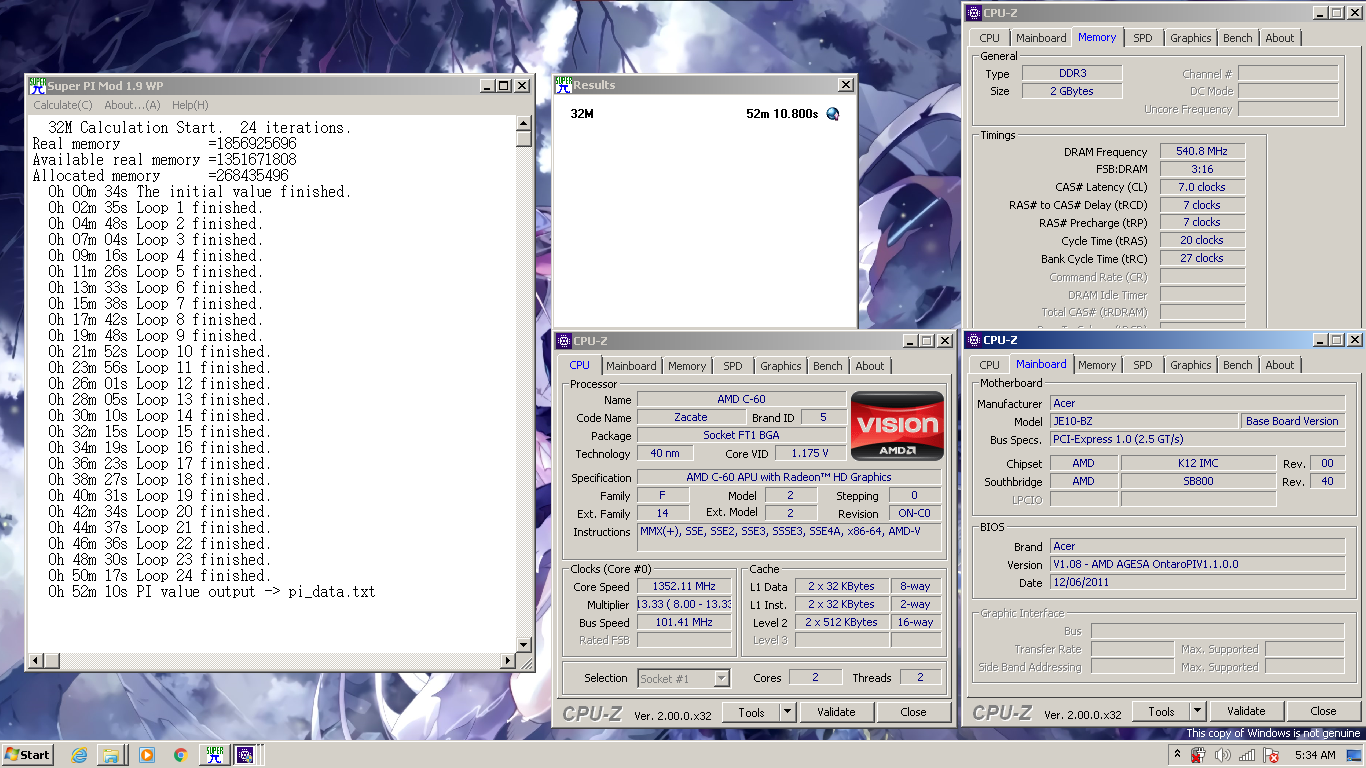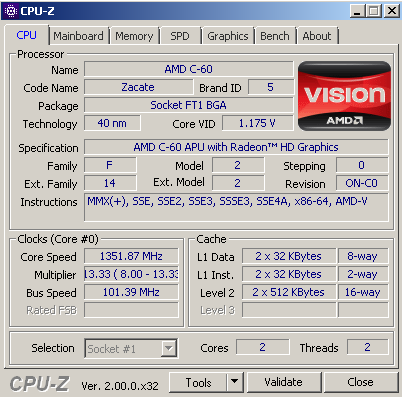SuperPi - 32M score 52min 10sec 800ms with a C-60
Friday, 08 April 2022 22:34 | Update at 3 years ago
Media Gallery
Screenshot

Device, Setup, etc


URL
https://hwbot.org/submission/4971042https://www.facebook.com/hakimnu.id/posts/3256532217912752
Information Detail
Hardware: AMD C-60
Specs:CPUID : AMD C-60 APU with Radeon(TM) HD Graphics
Architecture : x86
Codename : Zacate
L3 Cache : -
Clock : 1GHz - 1.3GHz
Core/Thread : 2/2
TDP : 9W
Technology : 40nm
Socket : FT1 BGA 413-Ball
IGPU : AMD Radeon HD 6290 Graphics
See more specification...
Software: SuperPi - 32M
Score: 52min 10sec 800ms
About: SuperPi - 32MSuperPi - 32M is one of the most popular classic benchmarks for measuring processor performance in single-threaded scenarios. This benchmark calculates the value of π (pi) to 32 million decimal places, which is a computationally intensive task and highly sensitive to single-core CPU speed and overall system efficiency.
SuperPi uses the computationally intensive Gauss-Legendre algorithm, so it takes a considerable amount of time to complete the 32M-digit calculation. For this reason, the benchmark is widely used by overclockers, reviewers, and hardware enthusiasts to test system stability, RAM tuning, cooling efficiency, and high clock speed performance.
Key Features of SuperPi - 32M:
- Measures single-core CPU performance: Focuses on the efficiency and speed of a single processor core.
- Emphasizes system stability: Ideal for testing overclock stability, temperature, and long-term performance.
- Classic and standardized benchmark: Widely recognized in the overclocking community and benchmark competitions.
- Sensitive to system configuration: Includes RAM latency, timing, and storage speed if swap is used.
The purpose of SuperPi - 32M:
SuperPi - 32M provides a realistic picture of how your CPU performs in scenarios that demand high performance from a single thread. This is crucial in real-world scenarios because many lightweight applications, older programs, and some modern game elements still run in a single-threaded manner. The faster the CPU completes this test, the more efficient your system is for light to medium-duty tasks.
Released in 2011, the AMD C-60 is a power-efficient processor from the Ontario series built on the Bobcat architecture. It has 2 cores and 2 threads, with a base speed of 1.0 GHz that can be increased to 1.33 GHz through Turbo Core technology. Designed specifically for portable devices such as netbooks and ultraportable laptops, the C-60 is focused on power efficiency and long battery life rather than high performance. With a TDP of just 9 watts, this processor enables ultra-thin and lightweight laptop designs without the need for complex active cooling systems. The main advantage of the C-60 is its extremely low power consumption, making it an attractive solution for users who need a lightweight computing device for daily activities with high mobility.
The AMD C-60 is also equipped with an integrated Radeon HD 6290 GPU, which has 80 shader cores and supports DirectX 11. Despite its modest specifications, this GPU is sufficient for multimedia purposes such as HD video playback, light graphics rendering, and old-school games with minimal graphics settings. However, overall, the performance of the AMD C-60 is limited and only suitable for light tasks such as browsing, typing documents, and using basic office applications. This processor will feel slow when used for heavy multitasking, modern software installation, or complex web-based applications. In tests using an Acer Aspire One 522 paired with 2GB DDR3 RAM and Windows 7 operating system, the processor was able to provide a decent user experience for basic needs, but was less responsive when compared to mainstream processors of the same generation. Even so, the AMD C-60 remains a viable solution for low-cost, power-efficient devices of its time.
Hardware Detail:
Device: Acer Aspire One 522
RAM: 2GB DDR3
OS: Windows 7
* Not Avaiable
